[Video] Vilgot is happiest when he’s using his NF-Walker

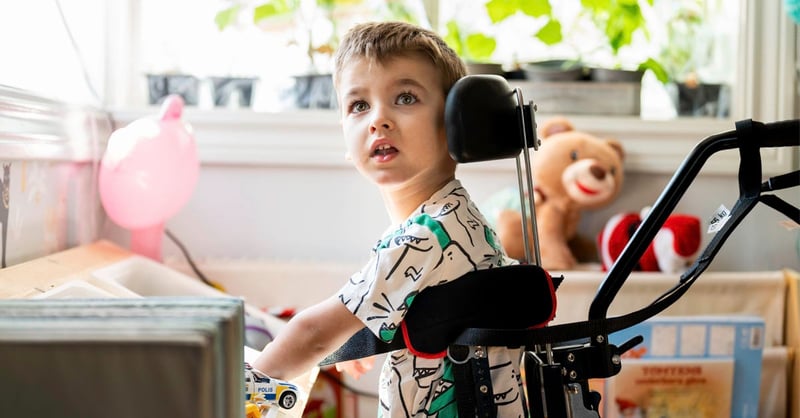
Vilgot is 5 years old and has dyskinetic cerebral palsy. He loves being active and moving around and is happiest when he’s able to use his NF-Walker.
This article is all about:
- Vilgot and his family
- Vilgot’s story
- Dyskinetic cerebral palsy
- His first assistive devices
- Running using the NF-Walker
- Vilgot’s strengths
Vilgot and his family
Vilgot is a gentle, high-spirited little chap who always looks on the bright side of life. He’s 5 years old, nearly 6, and he’ll be starting school in autumn 2023. He lives in Sweden with his mother Stina, his father Lars, and his two older brothers aged 12 and 14. Their golden retriever Svante and cats Svea and Reine also bring joy to the family home. Vilgot is inquisitive and loves to be involved in everything the family is doing, like playing football, fishing and riding a quad bike. He has just been given a new bike, and this is an activity he highly appreciates doing together with his brothers.
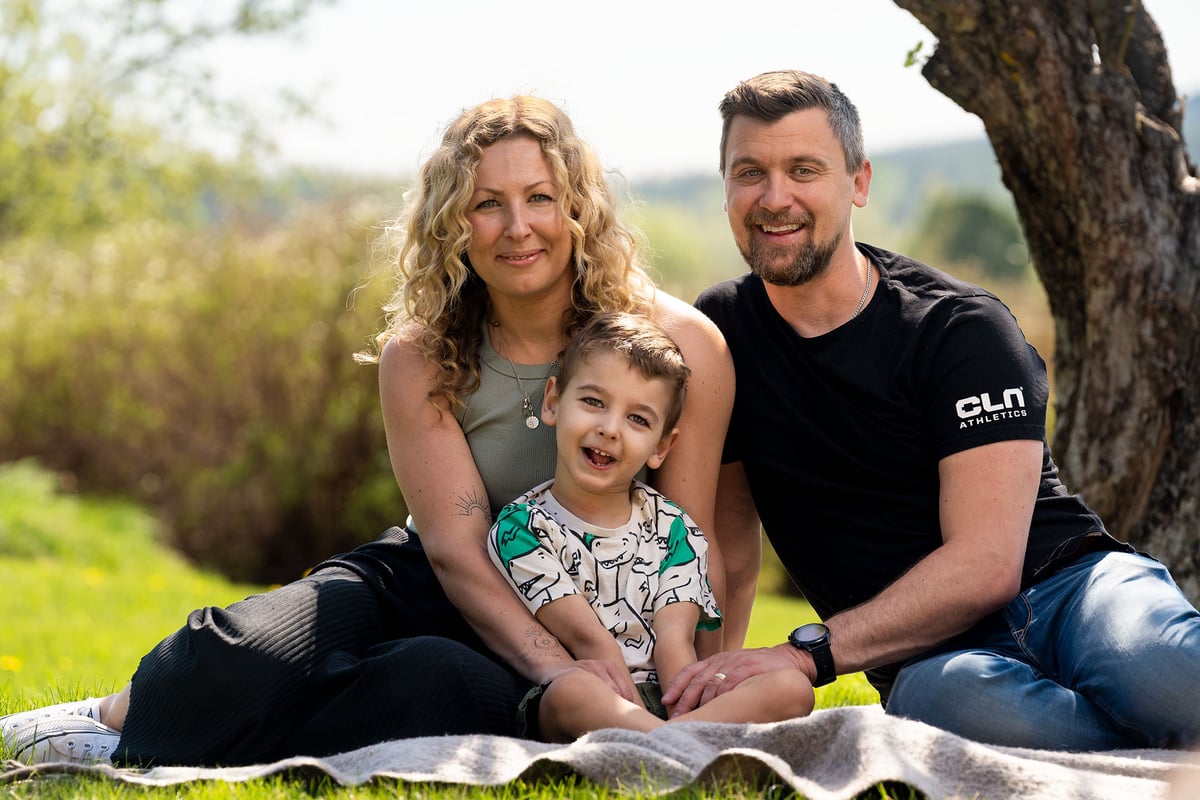
Vilgot’s story
When she was 38 weeks pregnant, Stina realised that her baby was suddenly moving a lot less than he had been, so she went to hospital for a scan. Everything seemed fine, but that same week Vilgot’s heart slowed, and medical action was taken to stimulate the heartrate, but eventually Stina underwent an emergency caesarean section when the baby began to struggle. Everything seemed fine as soon as Vilgot was born, but after an hour, things took a turn for the worse and they were at risk of losing their baby son. Vilgot had what’s known as Persistent Pulmonary Hypertension of the Newborn (PPHN). This is a clinical syndrome which is due to problems when the baby makes the transition from foetal to neonatal circulation. It was very serious, and Vilgot was put on a ventilator. The situation was particularly dramatic due to the fact that a snowstorm was raging on the day Vilgot was born, and the helicopter that was sent to fly the seriously ill baby to Uppsala (University hospital in Sweden) was unable to land. In the interim, the doctors fought to save Vilgot’s life. And when he had been stabilised, the snowstorm passed and he was flown to Uppsala for further treatment. While in hospital, Vilgot suffered from a convulsive seizure and received medication for it. His parents watched over their sleeping baby and hoped for the best. Although he was hooked up to lots of tubes initially, eventually just the probe was left connected up. Vilgot was stable, and it was time for him to head back to the local hospital.
Dyskinetic cerebral palsy
An MRI scan was carried out as Vilgot had had convulsive seizures, and unfortunately this showed he had suffered brain damage. The damage extended over a number of areas of his brain, and the doctors found it difficult to provide any indication of the consequences and extent of the damage so early on.
The news resulted in a rollercoaster of emotions for Stina and Lars, causing them to ask questions such as: “Does he have cerebral palsy?” and “What will the damage mean for him?”
Stina and Lars noticed that Vilgot’s movements were unusual when he was a tiny baby, and they also noticed he found it hard to swallow and choked on his milk a lot. These were all symptoms that they now realise were caused by his dystonia.
When he was five months old, they were told he probably had CP. Even though they already knew this deep down, they were very upset and felt very alone.
Vilgot was diagnosed with dyskinetic cerebral palsy when he was two years old. He faces motor skills challenges and is non-verbal. Vilgot frequently uses an eye-driven communication device at present.
What is dyskinetic cerebral palsy?
Dyskinetic cerebral palsy occurs in about six per cent of people with CP and is caused by damage to the basal ganglia, which are located deep in the cerebrum. Dyskinesia is involuntary movements, which can’t be controlled by the individual. These movements may be intermittent and repetitive.
His first assistive devices
When Vilgot was 8 months old, the family started receiving input from the therapy service and they received their first assistive device at home. Stina clearly remembers this device: it was a work chair, the ugliest thing she’d ever seen. Several years later, the house is full of assistive devices that Vilgot uses to participate in everyday life, and Stina’s views have now changed completely. Vilgot isn’t all that keen on being strapped into his chair, and he’s happiest with equipment that allows him more freedom to move. The therapy service provided him with a walker when he was just around 1 year old, and when he used it, it was the first time he was pleased and happy. Otherwise, he preferred to sit on his Mummy’s or Daddy’s lap.
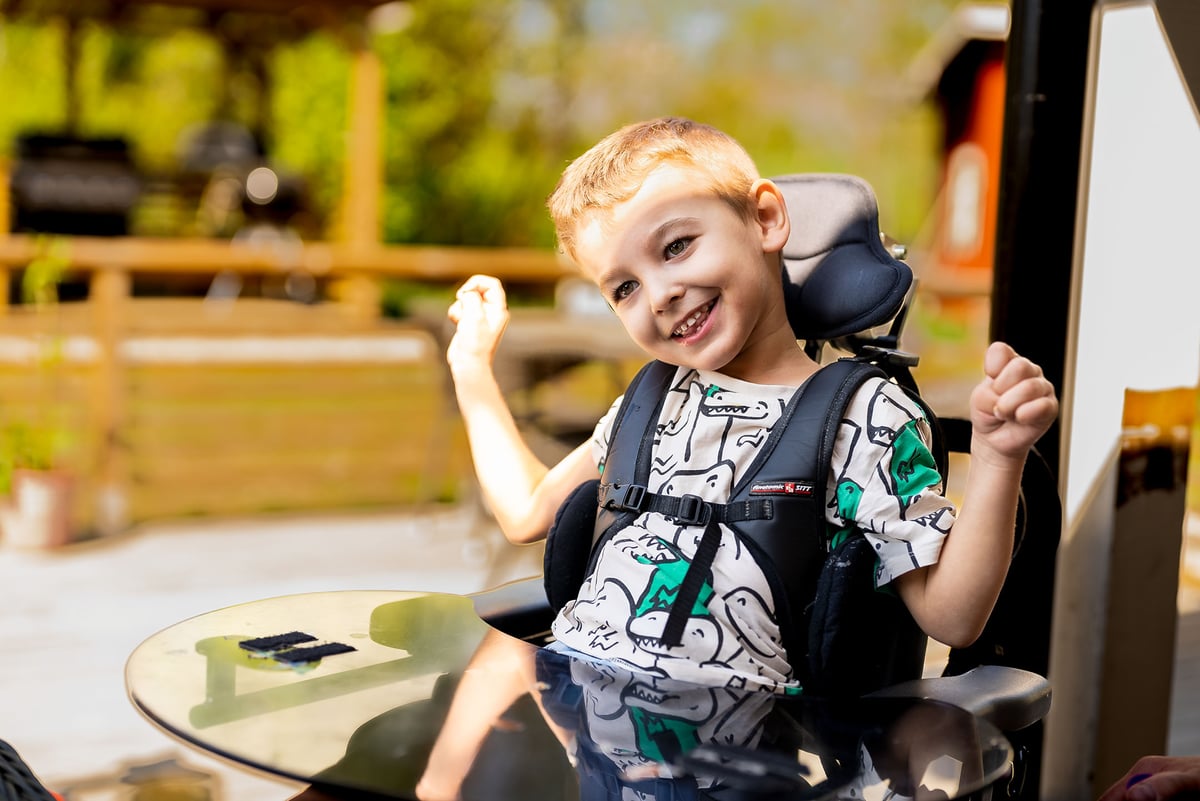
Running using the NF-Walker
When Vilgot was 4 years old, his physiotherapist recommended trying out the NF-Walker, and shortly after he had an assessment at the therapy department. Vilgot’s father Lars recalls how this was a moment he’d never forget. When Vilgot was standing in the NF-Walker, his initial reaction was to look sceptically at the NF-Walker frame in front of him. Then when he had peered at it closely for a little while, he straightened up his body and ran off. Stina and Lars hadn’t seen Vilgot walking for a while at that point, as he had somehow lost the ability to move forward. But then all of a sudden, off he ran along the hallway. Everybody was cheering him on, and they were moved to tears to see what he was actually capable of achieving.
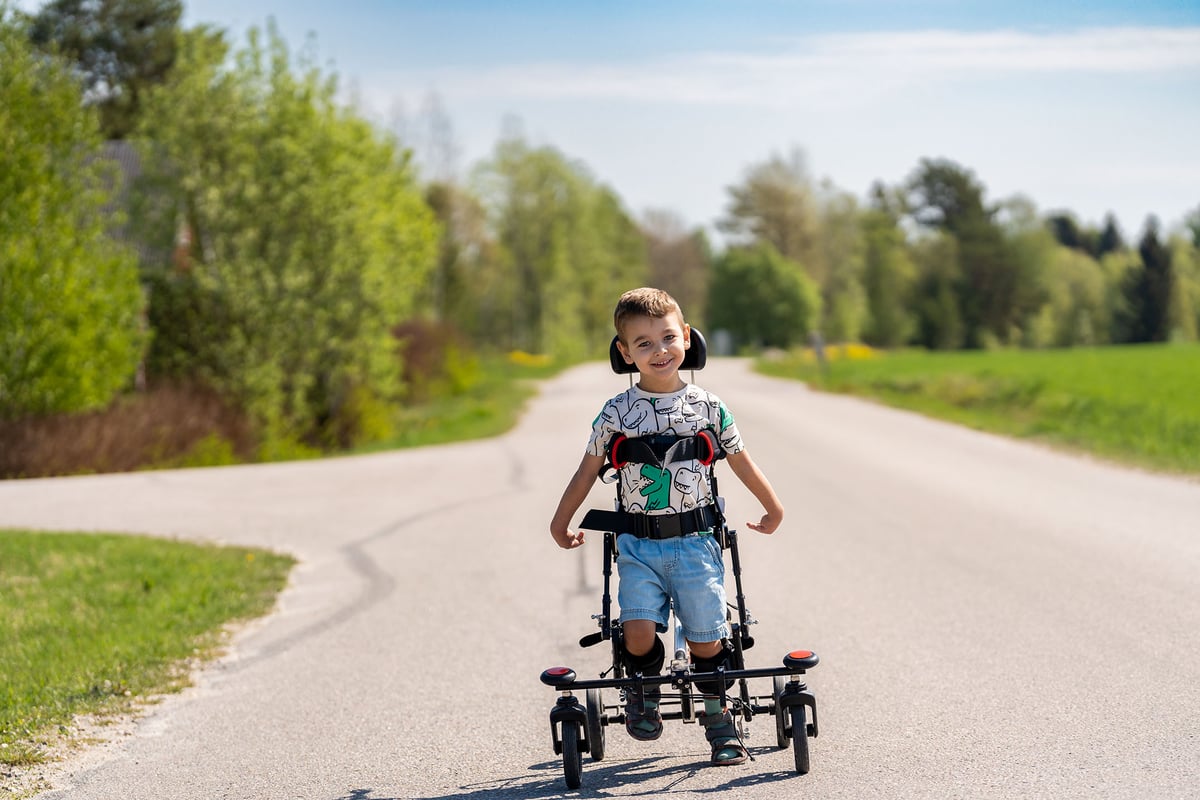
The NF-Walker provides Vilgot with the support he needs to be able to use his strength to move forward, and this is now the walking aid he prefers. Stina is pleased to describe how Vilgot has been able to start walking again, like he did when he was little. Walking was his strength, but the more he grew, the less force and length there was behind his steps, and he walked less and took small steps. “It’s like the NF-Walker has enabled him to walk again. He’s regained that wonderful feeling that he had when he was little, that he lost because of all those heavy assistive devices.” “This is what he wants. It’s obvious he feels free,” Lars adds.
Vilgot uses his NF-Walker both indoors and outside. Indoors, he can get close into the play table in his room and hands are kept free so that he can play. Outdoors, he enjoys running around with his brothers.
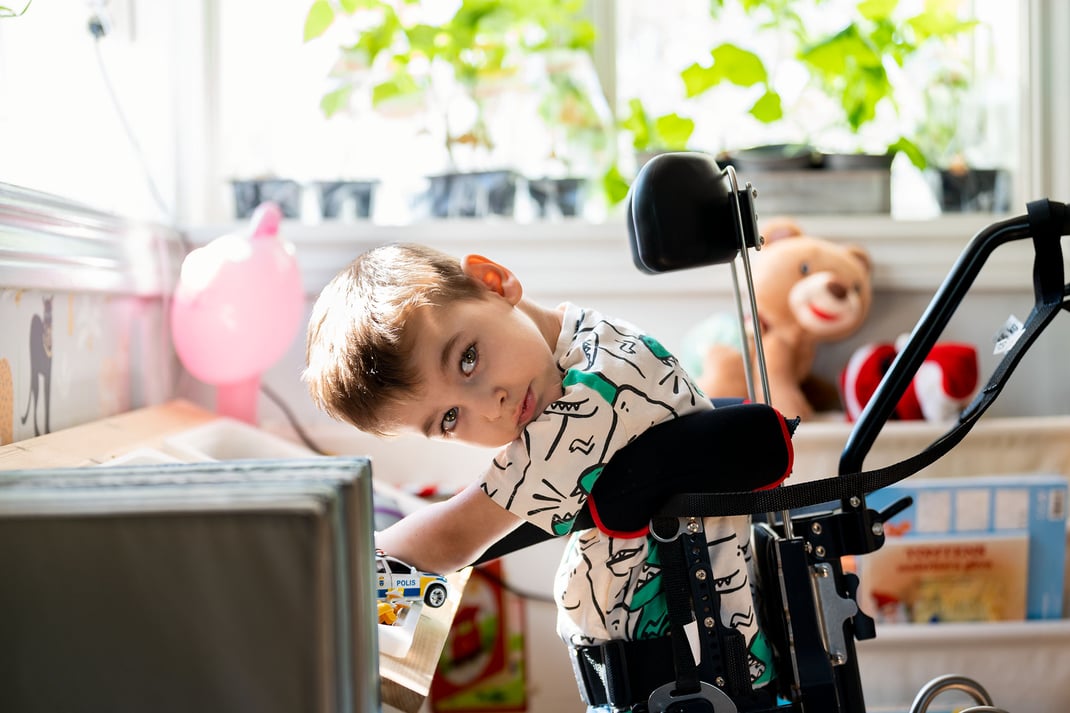
Vilgot’s strengths
Vilgot is a happy and high-spirited boy, and those are his strengths.
"In addition, his legs are strong and brings him forward," says Lars, Vilgot's dad. "And he really wants to use his legs. Usually, we support him when he walks, or he uses the NF-Walker for walking. He enjoys walking with us and playing with his brothers when in the device".
It’s as though he’s happiest when he gets to move around the way he wants to, when his legs are moving, says Stina.
Vilgot makes it clear that he enjoys taking part in all the activities that the family does together, and they choose to look at the opportunities available, rather than the obstacles. The family head out onto the ice to fish in winter, and Vilgot goes with them. On the slalom slope, Lars stands behind him for safety and controls his bi-ski. They barbecue sausages when they’re on holiday in the forest in autumn. And why shouldn’t Vilgot in his NF-Walker be allowed to help rake up the autumn leaves in the garden? And jump into the heaps of leaves afterwards?
“I’d like to say make the most of your time together. I think that’s important. Look at the positives, enjoy those little moments. To be happy, you don’t need to do big things. You have to live in the moment, and we enjoy lots of fabulous times with Vilgot. It’s fantastic, in my view. Just seeing him grin is incredible” Lars.
Stina has set up a Swedish Instagram account Helt Enkelt CP (Translated: Simply CP) #heltenkelcp, where you can follow a number of families where at least one child has been diagnosed with CP. The aim of this account is to raise awareness and reduce prejudice.
Watch the video of Vilgot and his family ⬇️
We would like to thank the lovely Vilgot and his fantastic family for sharing their story with us. We hope our account of their experiences helps to provide hope and inspiration to other families who are in the same situation.

Rikke Damkjær Moen brings many years of experience as clinical physiotherapist to the Made for Movement team. Her mission is to ensure that everybody, regardless of mobility problems, should be able to experience the joy and health benefits of physical activity. As our Medical Manager, Rikke is passionate about sharing knowledge so that individuals with special needs, families, and clinicians can discover the possibilities and solutions provided by Made for Movement.
The F-words: Fitness, Function, Friends, Family, Fun and Future help practitioners, educators, and families to create a supportive and...
It's a very special story marked by love, effort, and unstoppable determination. It's about Tom and his family. In the interview,...
A severe accident during a hockey game resulted in 35-year-old Tobias breaking his neck and becoming paralysed from the armpits down....
Hear from us from time to time and learn new things
